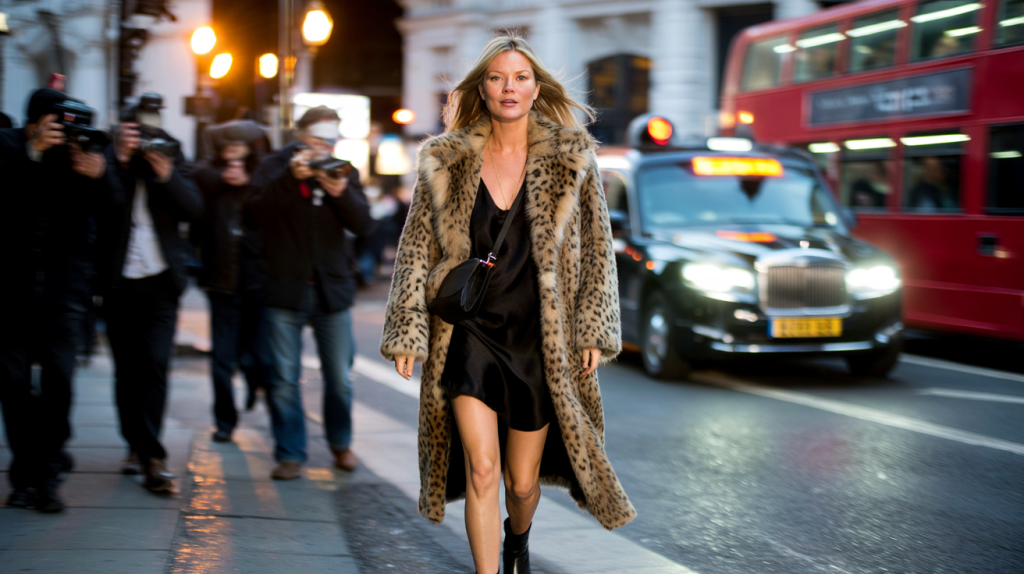One photograph of Kate Moss in a slinky leopard coat can still send a ripple through style feeds. The British model made the print feel effortless in the 1990s, then kept wearing it through the 2000s, shaping a look that reads rock, refined and a touch unruly all at once.
The context is simple and compelling : repeated street shots in leopard turned Kate Moss into the reference for this coat. British Vogue archives and Getty Images galleries document appearances across the mid to late 1990s and 2000s, from off-duty evenings to gigs and fashion week doors, proving the look never left. And yes, Google Trends shows interest in “leopard coat” rising every fall in the UK across the past five years.
Kate Moss and the leopard coat : how a 1990s habit became a signature
Early on, paparazzi frames caught Kate Moss pairing a leopard coat with skinny jeans and ankle boots, then with slip dresses that echoed her Calvin Klein era minimalism. The contrast clicked. It still does.
The timeline matters : the model’s Topshop collaboration launched in April 2007, then returned in April 2014, each time rekindling her high street pull and keeping animal prints in mainstream sight, as covered by British Vogue and The Guardian at the time. Runways mirrored the mood too, with Hedi Slimane’s Saint Laurent shows in 2013 featuring leopard outerwear that amplified the rock chick aesthetic.
Those images set expectations around the cut. On Moss, the coat usually hits mid thigh to knee, slightly oversized, and rarely looks pristine. That micro-slouch reads lived-in rather than costume.
From runway orbit to real life : why the piece still trends
The coat survives trend cycles because it behaves like a neutral while feeling bold. Season after season, street style galleries confirm the print sits next to denim, black tailoring, white tees and satin slips without friction.
There is also a cultural shift : luxury brands moved away from real fur, pushing faux and textile innovation. Gucci announced a fur-free policy in 2017, Prada Group followed from 2019, and Saint Laurent moved fur-free in 2021. Those dates, reported by the companies and fashion press, reframed leopard as a print story, not a fur story.
Sustainability adds another layer. The Ellen MacArthur Foundation’s 2017 report “A New Textiles Economy” found 73 percent of clothing ends up landfilled or incinerated and less than 1 percent is recycled into new garments. Investing in a durable leopard coat – vintage or quality faux – counters that churn and keeps a hero piece in rotation for years.
How to get the Kate Moss leopard coat look today
Leopard still works, but execution counts. The goal : ease, not preciousness.
Try this playbook when shopping or styling a leopard coat inspired by Kate Moss :
- Go slightly oversized : room for a knit and that slouch that makes it look lived-in.
- Keep the base simple : straight jeans, a white tee, or a black slip dress for evening.
- Ground it with boots : ankle or moto boots mirror Moss’s off-duty balance.
- Dial down accessories : one leather belt or a small shoulder bag is enough.
- Pick print tones that age well : tan, black and warm brown read classic, not novelty.
For fabric, modern faux fur and wool-blend jacquards both deliver. Faux fur channels the 90s paparazzi vibe. A tailored wool version leans city classic and layers cleanly under a trench or blazer when cold snaps hit.
Price, resale, longevity : making the coat earn its keep
Leopard coats sit across budgets, from high street wool blends to designer jacquards. Vintage remains a smart path : platforms like Vestiaire Collective and The RealReal authenticate listings and surface older cuts close to Moss’s proportions. Condition photos matter, as do fiber blends that resist matting at shoulders and cuffs.
Care keeps the print sharp. Hang on a broad-shoulder hanger, brush faux fur lightly after rain, and spot clean lining to extend life between specialist cleanings. These small steps stretch cost-per-wear across many winters.
One last piece to complete the picture : context. The Kate Moss effect was never only about the coat. It was the mix – a slip, a tee, a skinny jean – that made the leopard feel relaxed. Aim for that balance and the look lands today just as decisivly as it did in 1996.
